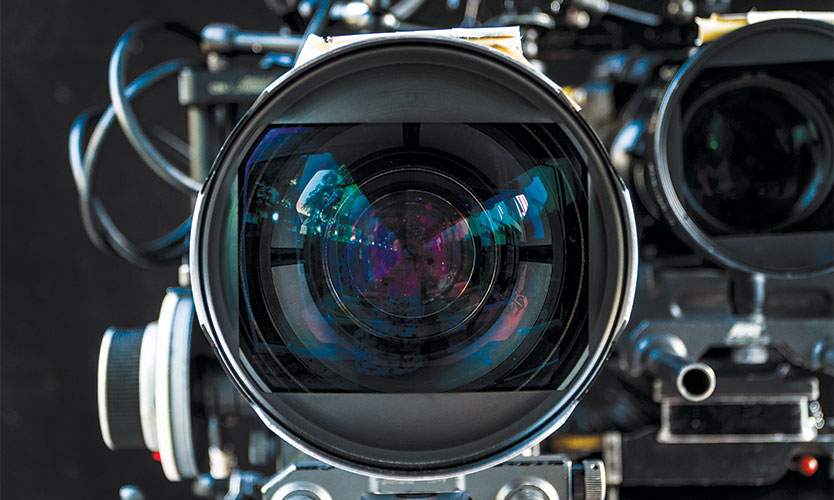The 2021 HBO miniseries that put on display the intimacy of married life — “Scenes from a Marriage” — gave viewers in the first few moments a glimpse of the lack of intimacy that goes on behind the scenes in the Hollywood of today.
Showing the moments of final preparations before the first call to action, camera operators and other crew members dashed by in masks, there were limited interactions among the crew, and stars were kept apart until the moment shooting began.
Entertainment risk and insurance industry executives confirm this as the standard scenery on film sets amid the COVID-19 pandemic.
“If the wardrobe people come on the set other people have to leave. … People are not allowed to visit each other on the set or in trailers, and masks for everyone, unless you are on camera,” said Peter Williams, Los Angeles-based global head of productions, entertainment division, at Allianz Global Corporate & Specialty, a unit of Allianz SE, covering film productions and risk management.
Filming during COVID-19 has ushered in a new way of doing business for an industry that often includes up-close-and-personal scenes. Since production schedules restarted after the first lockdowns in 2020, film sets have had to embrace pandemic nuances, such as social distancing, and must comply with federal, state and local guidance, along with official “return to work” rules put in place by unions such as the Screen Actors Guild-American Federation of Television and Radio Artists.
In addition, there are few insurance products that cover losses due to cast and crew infections, and the production pauses and shutdowns that inevitably follow.
“Like every industry in 2020 (the film and television) industry did get shut down and no one knew what to do,” said Aaron Baum, vice president for the entertainment and media industry practice group at Marsh LLC in Chicago. COVID-19 created “catastrophic” losses for the entertainment industry, filming permits were pulled, and billions in claims were filed with mixed results, he said.
Now “everything COVID is excluded,” said Lori Vitagliano, associate vice president and account executive of the entertainment group at Lockton Cos. LLC in Los Angeles.
In 2020, the entertainment insurance sector was hit with claims “on a daily basis” for the shutdowns imposed on productions in the United States and abroad, Mr. Williams said.
“By and large the film industry began excluding COVID as soon as it became a major problem,” he said.
Soaring content demand
The gap created by a lack of coverage left rigid safety protocols as the only way to keep the business on set, while the demand for new television shows and movies soared, with most people holed up in their homes for months.
“There is this demand” to continue making films and television shows, said Michael Greear, Eagle, Colorado-based senior risk control consultant with Aon Global Risk Consulting, a division of Aon PLC.
People “don’t want to watch a show once a week; they want to watch a show all at once on a Saturday afternoon,” he said. “The streaming content has amped up and we are seeing more and more get pumped out to these streaming services.”
“If anything, demand is still picking up,” said Mr. Baum.
A state of the market report released by Risk Strategies Co., the trading name of RSC Insurance Brokerage Inc., on Feb. 3 noted that while demand for productions pushed the industry into a pre-pandemic stride, “complications from COVID still lingered,” with a 20% increase in insurance rates for film and television productions and virus-related exclusions commonplace.
Experts say that while other industries fumbled to get back to work early in the pandemic Hollywood pressed on. Within months of the start of the pandemic in early 2020, the SAG-AFTRA union had in place its own COVID-19 filming protocols to get the industry back in action.
The protocols can add up to 30% to the final bill for productions, according to experts, who say costs to implement such added tasks as social distancing, testing, coordinating shooting schedules and managing on-location travel quarantines can add up. Any pause in production — commonplace, especially with new COVID-19 variants — also cuts into the bottom line, they say.
Mission made possible
The protocols have created some controversies.
Megastar Tom Cruise made headlines in late 2020 on the London set of the latest “Mission Impossible” film after he was caught on tape berating film crew members who had been standing too close together. That production faced seven COVID-related shutdowns, one of which prompted a lawsuit against its insurer.
The profanity-laced spectacle made for a YouTube sensation, but to those who manage the business side of a production, Mr. Cruise had a point.
After early shutdowns in 2020, “the guilds and studios spent a lot of money protecting the cast and crew so they could return to work,” Mr. Williams said.
Following months of deliberations, the unions and studios agreed to a blueprint of protocols to get the business rolling again. “It’s training, testing, hygiene, cleaning — you name it,” Mr. Greear said.
The COVID-19 vaccine, when it became widely available in early 2021, was roped in, with studios and unions at first recommending vaccinations and later requiring them. Netflix Studios, for example, began requiring employee vaccinations in mid-2021.
The protocols also call for COVID-19 compliance officers on set — they’re now listed in production credits — and separate zones for cast and crewmembers based on production roles in an effort to maintain social distancing when possible.
As Mr. Greear explained, “Zone A” typically includes the actors and directors, “Zone B” are the camera operators and “Zone C” and “Zone D” include “everybody else” — many of whom work remotely in post-production operations.
Travel comes with strict quarantine requirements, and actors are asked to be extra careful when not filming. “Actors are encouraged to not go out to supermarkets and restaurants while shooting,” Mr. Williams said.
Filming scenes out of sequence is also common, with production companies rearranging shooting schedules among actors and other cast members, such as extras and those in larger ensemble scenes, to mitigate exposures in the event of a COVID-19 outbreak, Mr. Baum of Marsh said.
Of all the protocols, testing has top billing, according to Ms. Vitagliano, whose husband works alongside set designers for a studio in Los Angeles. She said it’s not uncommon for actors and crew members to get tested every day on set. Her husband, who works behind the scenes as a “greensman” only working with plants, gets tested three times a week, she said.



